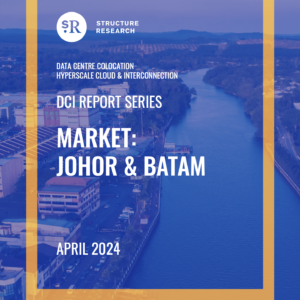Description
The data centre colocation market in Jakarta, Indonesia continues to push forward amid a rapidly transforming landscape. There are both headwinds and tailwinds blowing at a critical turning point in the sector’s relatively short history. Over 65MW of hypersale colocation inventory is set to come online in 2025 and the market is projected to effectively double its overall capacity by 2030. This comes as questions continue to be asked about a possible oversupply situation and the long-term viability of AI demand.
Taking a look back, Jakarta was set to take off as a major market when hyperscale cloud started to land in the 2017-18 time frame, but the global pandemic hit and not all of the hyperscale clouds had come online at that point (only Alibaba Cloud and Google Cloud). The pandemic complicated data centre infrastructure development as supply chain issues, pandemic and travel restrictions, and the various challenges of new market entry lengthened the process of getting infrastructure online. And towards the end of the pandemic, macroeconomic headwinds emerged and the decision by a few hyperscalers to self-build reset the demand profile.
But there have always been strong believers in the long-term potential of the Jakarta data centre market, and even during this eventful period, there was significant domestic and international interest and strategic activity in the sector. And this eventually paved the way for a wave of new entries, creating a relatively crowded competitive landscape. But in the last few years, only a handful of operators have won the bulk of the core-hyperscale business. This was one of a few factors that led to an imbalance emerging between supply and demand, creating fears of an oversupply situation. Another byproduct of the core-hyperscale competition was the pivot into the central Jakarta cluster as operators and investors decided to go after a different profile of deployment and opportunity.
The addition of a significant volume of inventory in 2025 will soon answer the questions around oversupply. And things are looking up. Hyperscale cloud is stabilising after a period of growth deceleration, the Chinese clouds have recovered and are investing CapEx, more hyperscale clouds are entering Jakarta, while AI and GPU-oriented clouds have come to market rapidly and injected demand into the pipeline.
Things are not perfect, of course. Hyperscalers have self-built and could take things in either direction going forward and the instability of the global economy could play havoc with the domestic market. Meanwhile, Thailand seems to have beaten Indonesia to the punch and emerged as the alternative AI hub to Johor, Malaysia in Southeast Asia. That is not going to prevent AI from landing in Indonesia, but it could take away a lot of the potential upside.
Overall, however the outlook is positive, and the market continues to grow, albeit at slower rates than before. The Jakarta data centre colocation market continued to grow at a steady pace since our last update and is projected to be worth USD $507.2m in 2025 from a total colocation spend perspective, and grow at a five-year CAGR of 11% through 2030. The market is expected to be worth $856m by 2030.
This report is an excellent resource for any service provider, investor or enterprise end user looking to understand and project the data centre market in Jakarta or find a service provider. The methodology applied continues to be the most robust in the industry. The supporting dataset is built from comprehensive asset-level tracking, capacity is measured purely on a power basis, and all the metrics are split along retail and hyperscale lines, and inventory aggregated in multiple tiers according to build status, absorption rates and maximum capacity levels. We have also delineated even narrower market segments, separating retail into enterprise retail and enterprise retail+, and split hyperscale into core-hyperscale and edge-hyperscale categories. Hyperscale self-builds are also tracked and a key component of the overall analysis. Hyperscale cloud nodes and on-ramps are mapped and a complete directory is provided.
Read the PDF report preview HERE.






